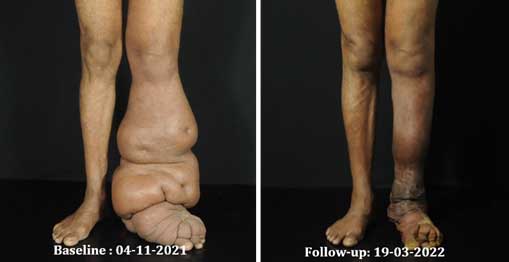Lymphatic Filariasis
Lymphatic Filariasis (LF) is caused by a microscopic worm that spread from person to person by the bite of an infected mosquito. The microscopic worms pass from the mosquito through the skin, travel to the lymph vessels and grow into adults. The adult worms then release millions of microscopic eggs called microfilariae, into the blood. People with live filarial worms in their blood can give the infection to others through mosquitoes. The microfilaria damage the lymph nodes and lymphatic vessels by which the flow of lymph fluid is impaired and causes massive lymphoedema (elephantiasis) of the legs, arms, breast, and genital area. There are no symptoms in the early stage of infection after receiving mosquito bites. This stage can last for several years. As the disease progresses the skin becomes much thickened and with overhanging folds resembling the foot of an elephant.
Major Symptoms
Cellulitis or Filarial fever is a common soft tissue infection affecting lymphoedema patients. Most commonly this occurs in the lower leg but can develop anywhere in the body. In severe infections, the inflammation can spread to the lymphatic vessels (lymphangitis) and cause damage. Frequent inflammatory episodes lead to swelling because of scarring (damage) around the lymphatic channels and will have the following symptoms.
- Fever
- Pain and tenderness.
- Warmth of the affected region.
- Erythema (redness).
- Increased swelling.
- Local lymphadenitis (infection of lymph nodes).
The flow of integrative treatment for Lymphoedema/Filariasis
- It starts with a session of counseling
- Examination by doctors and deciding on the treatment protocol
- Blood and Urine Investigations
- Photo Documentation,
- Volume Measurement,
- Girth Measurement-done to monitor the treatment outcomes
- Duration of stay depends the on the disease and associated complications. It ranged from 7-28 days
- Out-patient day-care-daily treatment lasts for 2 to 3 hours
- Treatment training of at least one member of the family on self-care and how to support the patient back at home
- Patient follow-up after the 30th and 60th days of discharge and periodically after that
- Patients continue treatment
- IAD supervision through WhatsApp is available on long-term home-based self-care
- The treatment components and duration may get simplified depending on the improvement of the affected limb

